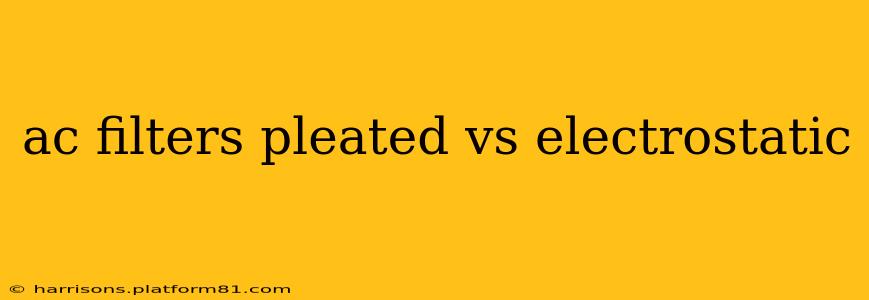Choosing the right air conditioner filter can significantly impact your indoor air quality and the efficiency of your HVAC system. Two popular options are pleated filters and electrostatic filters. Understanding their differences is key to making an informed decision. This comprehensive guide will delve into the specifics of each, helping you determine which type best suits your needs.
What are Pleated AC Filters?
Pleated air filters are the most common type found in homes. They consist of a pleated material, usually fiberglass or synthetic fiber, enclosed within a frame. These pleats increase the filter's surface area, allowing it to trap more airborne particles before they reach your HVAC system. The density of the pleats determines the filter's efficiency; higher density means more efficient particle capture.
Advantages of Pleated Filters:
- Widely Available: Pleated filters are readily available at most home improvement stores and online retailers.
- Affordable: Generally, they are less expensive than electrostatic filters.
- Varying Efficiency Ratings: You can find pleated filters with varying Minimum Efficiency Reporting Values (MERV) ratings, allowing you to choose a filter appropriate for your needs and air quality concerns. Higher MERV ratings indicate greater efficiency.
Disadvantages of Pleated Filters:
- Can Restrict Airflow: Highly efficient pleated filters can sometimes restrict airflow, reducing the efficiency of your HVAC system and potentially increasing energy consumption.
- Require More Frequent Replacement: Due to their lower capacity, they need replacing more often than electrostatic filters.
- Less Effective at Capturing Smaller Particles: While high-MERV pleated filters can capture smaller particles, they might not be as effective as electrostatic filters in this regard.
What are Electrostatic AC Filters?
Electrostatic air filters, also known as electronic air cleaners, use an electrically charged media to attract and trap airborne particles. They typically consist of a series of charged plates or fibers that capture particles through electrostatic attraction. This process is often more effective at trapping smaller particles, such as dust mites, pollen, and pet dander.
Advantages of Electrostatic Filters:
- Higher Efficiency: Electrostatic filters are generally more efficient at trapping smaller particles than pleated filters.
- Longer Lifespan: They often last longer than pleated filters, reducing replacement frequency and costs over time.
- Improved Air Quality: Their superior particle capture contributes to better indoor air quality.
Disadvantages of Electrostatic Filters:
- Higher Initial Cost: Electrostatic filters usually have a higher upfront cost compared to pleated filters.
- Potential for Ozone Production: Some electrostatic filters can produce ozone, a pollutant that can irritate the lungs. Ensure your chosen filter is ozone-free.
- Maintenance Requirements: While they last longer, they might require periodic cleaning or replacement of the filter media.
Pleated vs. Electrostatic: Which is Better?
The "better" filter depends entirely on your individual needs and priorities.
-
For budget-conscious consumers who prioritize affordability and readily available replacements, pleated filters are a good option. Just remember to choose a MERV rating appropriate for your needs and replace them frequently.
-
For those prioritizing superior air quality and longer filter lifespan, electrostatic filters are a worthwhile investment. However, the higher upfront cost and potential maintenance should be considered.
How Often Should I Replace My AC Filter?
This depends on the filter type and your specific environment (e.g., pets, allergies, level of outdoor pollution). As a general rule:
- Pleated filters: Should be replaced every 1-3 months, or more frequently if needed.
- Electrostatic filters: The lifespan varies depending on the model but can often last 6-12 months or longer. Always consult the manufacturer's recommendations.
What MERV Rating Should I Choose?
The Minimum Efficiency Reporting Value (MERV) rating indicates a filter's efficiency in removing particles of various sizes. Higher MERV ratings (e.g., MERV 13-16) indicate better particle capture, but can also restrict airflow. Choosing the right MERV rating involves balancing efficiency with potential airflow restrictions. Consider your specific needs and consult with an HVAC professional for personalized advice.
Can I Clean Electrostatic Filters?
Some electrostatic filters are washable and reusable, while others require replacement of the filter media. Always refer to the manufacturer's instructions for cleaning or replacement procedures. Improper cleaning can damage the filter and reduce its effectiveness.
Are Electrostatic Filters Safe?
Modern electrostatic air filters are generally safe when used correctly. However, it's essential to choose ozone-free models and follow the manufacturer's instructions. If you have concerns, consult with an HVAC specialist.
This information should provide you with a solid understanding of the differences between pleated and electrostatic air filters. Making the right choice depends on balancing your budget, desired air quality, and maintenance preferences. Remember to always consult your HVAC system's manual and consider professional advice for optimal performance and indoor air quality.
